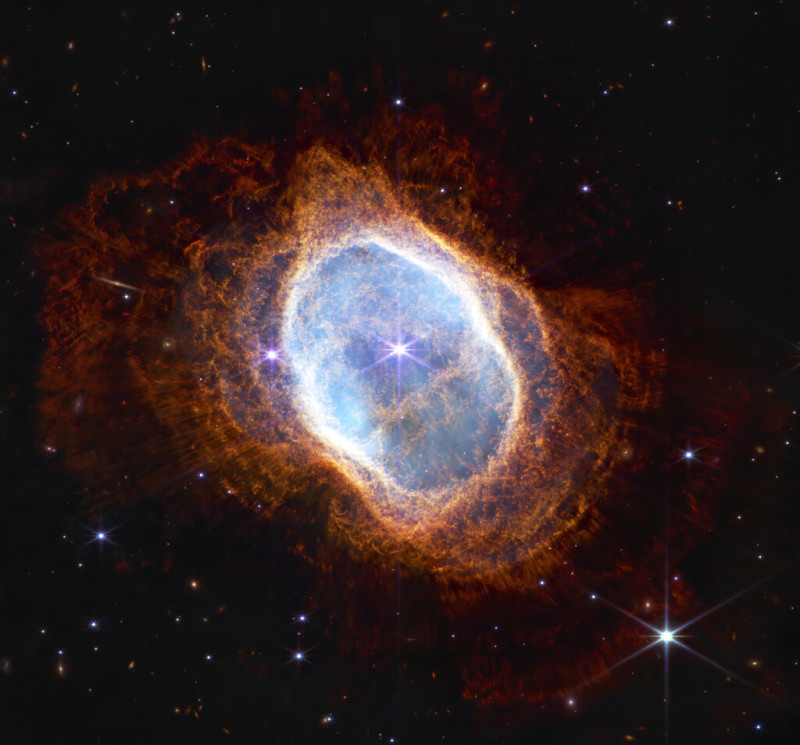The most powerful telescope ever sent into space, Webb launched on December 25, 2021, and NASA shared its first set of images on July 12, 2022
The James Webb Space Telescope has captured a stunning new image of the closest star-forming region to Earth, located 390 light-years away.
The release of the image marks the first anniversary since the space telescope began observing the universe.
Webb’s detailed close-up shows the chaos of the Rho Ophiuchi cloud cluster, where intersecting jets from young sun-like stars hit the interstellar gas and make it glow. Some of the stars are wreathed in shadows that hint at the spinning disks, the swirling rings of gas and dust where planets are born.
The cloud cluster contains 50 stars similar in mass to our sun, meaning these future planetary systems may resemble what our own solar system looked like in the beginning.
The darkest parts of the image are where the stars that are still forming are shrouded in dust, while jets of molecular hydrogen make bright red splashes.
“Webb’s image of Rho Ophiuchi allows us to witness a very short period in the stellar life cycle with greater clarity. Our own Sun experienced such a phase a long time ago, and now we have the technology to see the beginning of another star’s history,” said Klaus Pontoppidan, a Webb program scientist at the Space Telescope Science Institute in Baltimore, Maryland, and researcher at NASA.
The most powerful telescope ever sent into space, Webb launched on December 25, 2021, and NASA shared its first set of images on July 12, 2022.
The space telescope’s first glimpses of the universe included distant galaxies, the atmospheric composition of an exoplanet and a stellar nursery, where stars are born.
“In just one year, the James Webb Space Telescope has transformed humanity’s view of the universe, peering into clouds of dust and seeing light from distant corners of the universe for the first time. “Every new image is a new discovery, enabling scientists around the world to ask and answer questions they once could not have dreamed of,” NASA Administrator Bill Nelson said in a statement.
“Webb is an investment in American innovation, but also a scientific achievement made possible with NASA’s international partners who share a can-do spirit to push the limits of what is known to be possible. Thousands of engineers, scientists and leaders have poured their life’s passion into this mission, and their efforts will continue to improve our understanding of the origins of the universe and our place in it.”
Uncovering the secrets of the universe
Webb captures images of the universe in infrared light, which is invisible to the human eye. The telescope cuts through dark gas and dust throughout the universe to reveal previously unseen features and show other celestial details with advanced precision.
While the initial images provided a glimpse of Webb’s capabilities, already the telescope’s first year of cosmic observations have awed and its discoveries both encouraged and surprised astronomers.
“On its first anniversary, the James Webb Space Telescope has already fulfilled its promise to unfold the universe, giving humanity an amazing trove of images and science that will last for decades,” said Nicola Fox, NASA Science Mission Associate. Address, in his statement.
“An engineering marvel built by the world’s leading scientists and engineers, Webb has given us a more sophisticated understanding of the galaxies, stars and atmospheres of planets outside our solar system, setting the stage for NASA to lead the world in a new era of scientific discoveries and the search for habitable worlds”.
One of Webb’s greatest strengths is capturing the faint light of incredibly distant galaxies. The telescope can essentially look back in time as it studies cosmic objects that formed shortly after the universe began.
Given the vastness of the universe, studying its early days is like looking back in time. Faint light from the oldest galaxies still travels across the universe to reach Earth, so the farthest point in the universe now visible to scientists is the light of the past.
In just its first year, the telescope has already spotted some of the most distant galaxies ever observed, which formed just a few hundred million years after the Big Bang.
Studying these galaxies, which were beyond the observational range of other telescopes, can help astronomers glean more details about the early days of the universe, including how the first galaxies and stars formed.
The telescope has observed a wide range of galaxies and other celestial objects, creating a catalog of cosmic phenomena that could change the way scientists understand the universe.
Source :Skai
I am Terrance Carlson, author at News Bulletin 247. I mostly cover technology news and I have been working in this field for a long time. I have a lot of experience and I am highly knowledgeable in this area. I am a very reliable source of information and I always make sure to provide accurate news to my readers.











